Introduction
In the rapidly evolving landscape of mobile applications, effective monetization strategies have become essential for developers seeking to maximize revenue and enhance user engagement. As we move into 2024, various approaches have emerged, each tailored to meet the demands of a diverse audience while leveraging technological advancements. From in-app advertising to subscription models, the choices are plentiful, yet the challenge lies in selecting the right mix that aligns with the app's objectives and user preferences.
This article delves into the most effective monetization strategies, providing insights and actionable recommendations for developers aiming to thrive in a competitive market. Understanding these strategies not only paves the way for financial success but also fosters a deeper connection with users, ensuring that the app remains relevant and valuable in an ever-changing digital environment.
Exploring Monetization Strategies for Mobile Apps
In 2024, to make money with mobile apps, monetizing mobile applications will involve utilizing various approaches that address the changing market landscape. Here are the most effective methods:
-
Application Advertising: As one of the primary methods of monetization, application advertising generates income through impressions, clicks, or interactions. With the global mobile application advertising revenue projected to soar, platforms like Google AdMob and Facebook Audience Network offer robust solutions for app developers aiming to capitalize on this trend.
-
In-App Purchases: This strategy enables users to acquire additional features, content, or virtual goods within the app. Especially profitable for gaming applications, purchases within the app enable players to improve their experiences, contributing to the $380 billion global market for such transactions. According to the Director of Product at Gameforge AI, "LTV is the highest priority metric to improve in the next 6 months," highlighting the significance of in-app purchases in driving long-term value.
-
Subscription Model: Implementing a subscription model can yield consistent revenue. By charging individuals a recurring fee for access to premium content, apps like Spotify and Netflix have demonstrated that this approach can build a loyal customer base while ensuring steady cash flow.
-
Freemium Model: Providing a basic version of the app at no cost while charging for premium features can effectively expand the audience. This allows potential customers to experience the app before committing financially, increasing the likelihood of conversion to paid features.
-
Sponsorships and Partnerships: Collaborating with brands for sponsored content or features can be immensely profitable. This approach involves integrating a brand’s products or services into the app experience, creating value for both the app developer and the brand.
-
Selling Merchandise or Services: If the app boasts a strong brand presence, consider leveraging it by selling merchandise or services directly through the app. This approach can enhance participant engagement while generating additional income streams.
While each monetization approach presents distinct advantages and challenges, understanding your app's nature, target audience, and market positioning is crucial to make money with mobile apps. Successful monetization necessitates robust cooperation between marketing and product teams to effectively assess preferences and behaviors—an essential factor for choosing the most effective strategy for your app's financial success. Recent insights from industry leaders highlight that fluctuations in Daily Active Users (DAU) often indicate marketing shifts rather than actual game performance, underscoring the need for continuous optimization of monetization strategies.
Additionally, the case study on First-Time Participant Experience (FTUE) Optimization emphasizes the importance of optimizing experience around breakeven points to enhance long-term engagement and revenue, making it a critical focus for app developers.
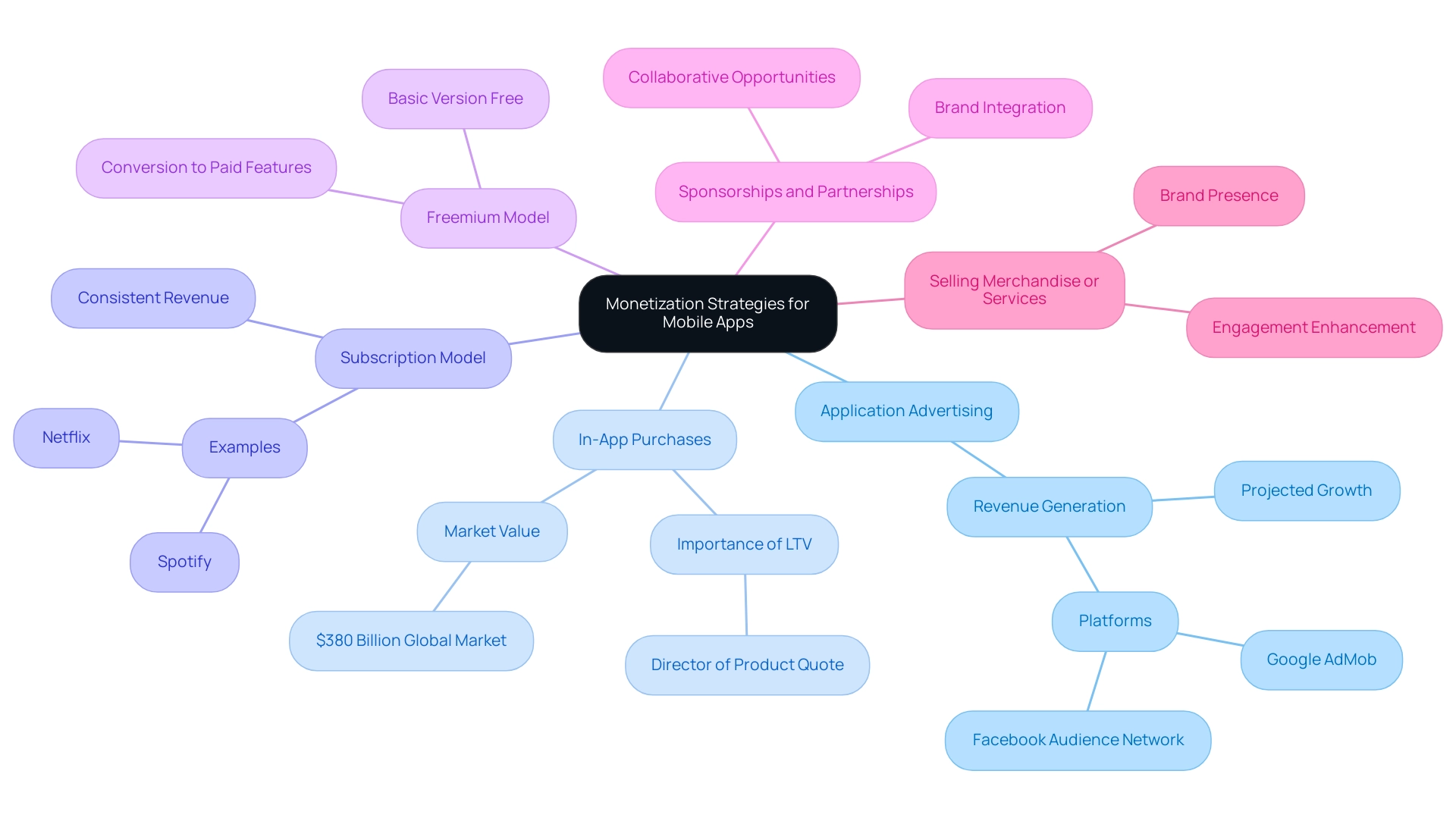
Implementing In-App Advertising
To effectively implement in-app advertising and maximize revenue potential, consider the following strategic steps:
-
Choose an Ad Network: Begin by researching and selecting an ad network that aligns with your app's objectives. Leading choices include Google AdMob, Unity Ads, and MoPub, which are recognized for their extensive reach and robust features.
-
Integrate the SDK: Carefully follow the documentation provided by your chosen ad network to integrate their Software Development Kit (SDK) into your app. This process typically involves incorporating specific libraries and code snippets into your app’s codebase, ensuring seamless functionality.
-
Set Up Ad Formats: Determine the types of ads that best suit your app. Popular formats include:
- Banner ads
- Interstitial ads—which are full-screen ads appearing at transition points
- Rewarded video ads, where individuals receive in-app rewards for engaging with ads.
Notably, 75% of businesses on Facebook utilize video ads, highlighting the effectiveness of this medium. Furthermore, 87% of online marketers use video content, with explainer videos being the most popular, underscoring the importance of incorporating video ads in your strategy.
-
Optimize Ad Placements: Experiment with various ad placements to identify the most effective locations that enhance revenue while maintaining the experience for visitors. Employ A/B testing to evaluate which placements generate the highest engagement and revenue without being intrusive.
-
Monitor Performance: Utilize the analytics tools provided by your ad network to track performance metrics. Focus on key indicators such as click-through rates (CTR) and revenue per thousand impressions (RPM) to assess ad effectiveness and make necessary adjustments.
-
Adjust Based on Feedback: Remain attuned to audience feedback regarding ads. Should individuals express concerns about ad intrusiveness, be prepared to modify ad frequency or placement to ensure a positive experience. As Brock Munro, Head of Product & Yield at Publift, emphasizes, understanding user sentiment is crucial for maintaining engagement in an evolving adtech landscape.
Furthermore, with mobile video usage expected to represent 76% of all mobile traffic by 2025, as emphasized in the 'Mobile Video Consumption Trends' case study, shorter mobile video ads are demonstrating equal effectiveness as longer formats, improving advertising approaches for marketers. The United States continues to lead in innovation and investment in the In-App Advertising landscape, making these strategies particularly relevant in the current market environment.
By following these steps, you can make money with mobile apps through app advertising while keeping your users engaged and satisfied.
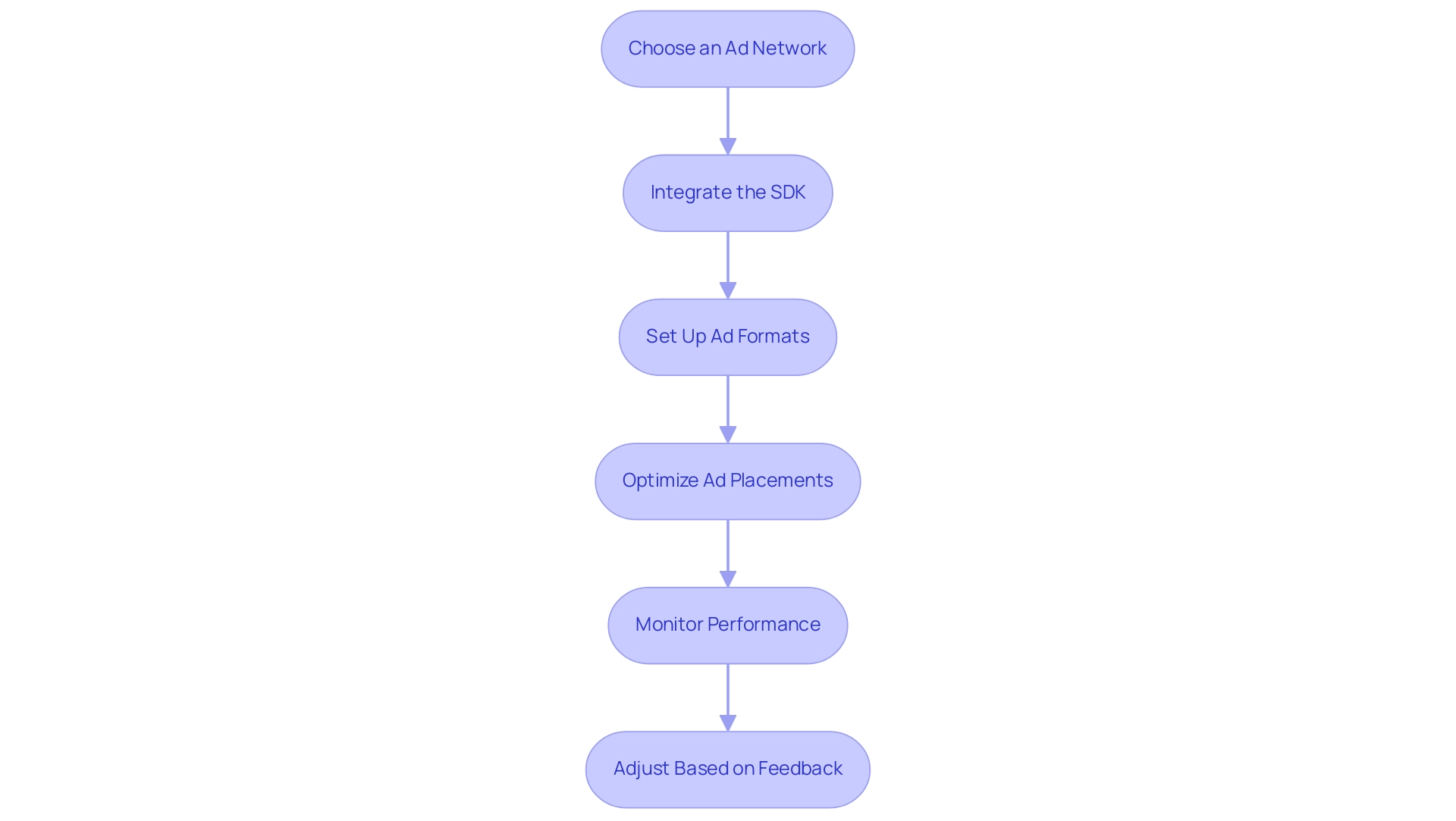
Leveraging In-App Purchases
To effectively utilize purchases within the application and maximize your app's revenue, consider the following strategic steps:
- Define Your Offerings: Identify the features or content that will be available as in-app purchases. This could range from premium features and additional game levels to exclusive content that enhances player engagement.
- Integrate Payment Processing: Make use of the app store's built-in payment systems, such as Apple’s In-App Purchase or Google Play Billing, which provide secure transaction management and streamline the purchasing process.
- Create a User-Friendly Purchase Flow: Design a seamless and intuitive purchase process. Minimizing friction is essential; individuals should be able to make purchases effortlessly, which encourages higher conversion rates.
- Promote Your App Purchases: Employ targeted marketing strategies to highlight your offerings within the app environment. Implementing limited-time discounts or exclusive bundles can create urgency and drive sales.
- Analyze Purchase Behavior: Utilize analytics tools to observe which purchases within the application are the most favored and how individuals engage with them. Understanding these patterns allows for informed decisions regarding future offerings and marketing initiatives.
- Iterate Based on Feedback: Regularly gather and analyze feedback regarding in-app purchases. Adjust your offerings based on what individuals value and what significantly enhances their overall experience.
- Understand Participant Disengagement: Enhancing reactivation rates requires identifying why individuals disengage and providing customized discounts to encourage their return, emphasizing the benefits of subscriptions.
- Leverage Geographic Segmentation: As demonstrated in the case study on initial renewal rates by region, understanding local variations can guide targeted marketing strategies, enhancing engagement and retention.
By carefully implementing purchases within the application, you can make money with mobile apps while simultaneously providing authentic value to your audience. As noted by industry expert Thomas Petit,
This explains why many apps tend to favor offering yearly plans, through price paywall design incentives, which can help with cash flow.
Furthermore, the statistic indicating that gaming applications constitute 28% of the apps accessible in China emphasizes the necessity of adapting to preferences and behaviors in 2024's evolving market.
Furthermore, the global daily active participant share of leading live streaming apps from 2020-2022 highlights the competitive landscape, emphasizing the importance of effective in-app purchase strategies.
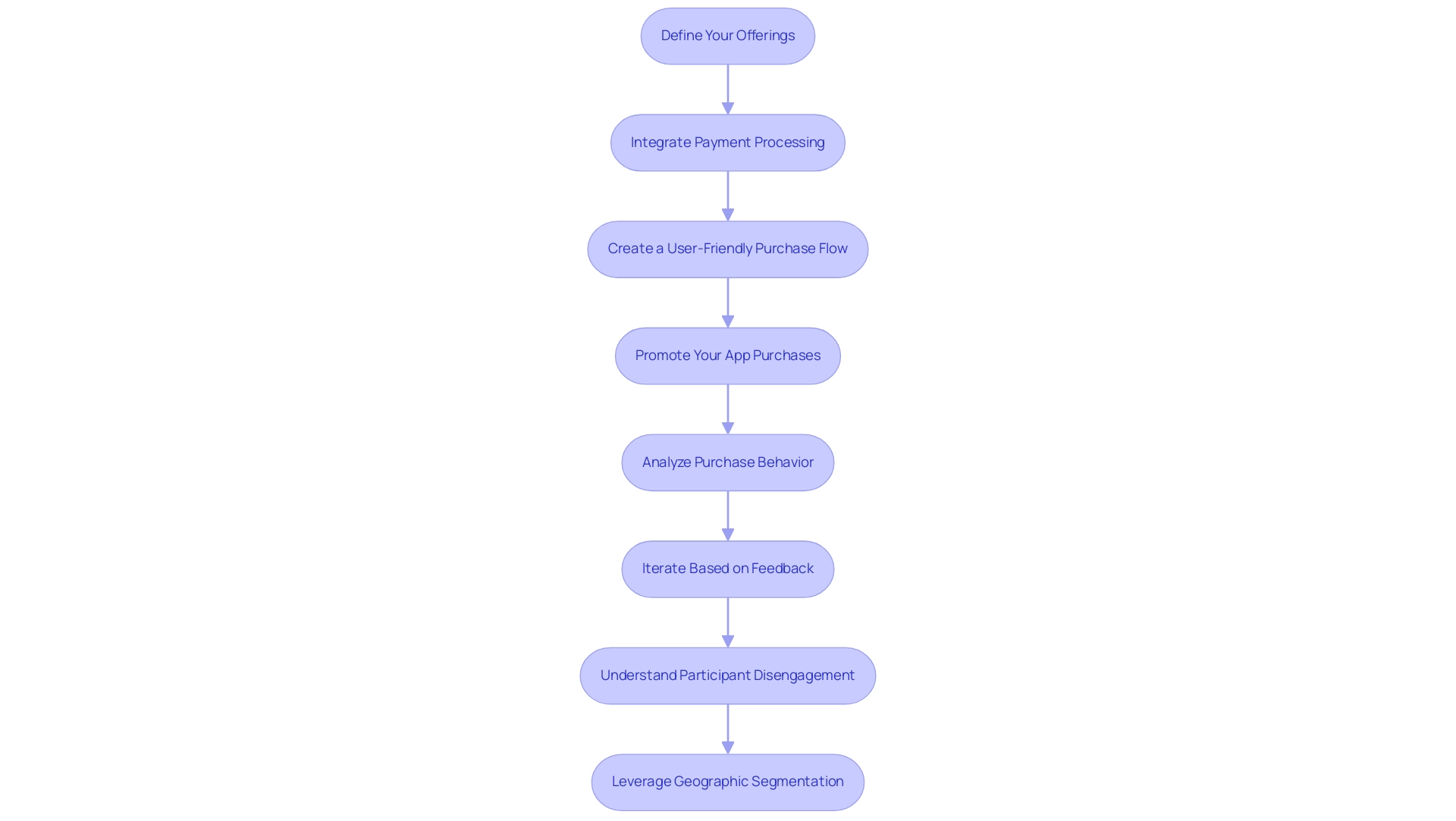
Adopting a Subscription Model
By implementing a subscription model for your mobile app, you can significantly boost revenue potential and make money with mobile apps while increasing customer engagement. Here are key steps to guide your implementation:
-
Determine Your Subscription Tiers: Establish various subscription levels tailored to different client needs.
Including a free trial can be an effective strategy to attract potential subscribers and showcase the app's value. -
Set Pricing: Competitive pricing is crucial. Investigate analogous applications to determine pricing models that offer benefits to consumers while ensuring profitability.
A well-calibrated price point is essential as it influences consumer perception and willingness to pay. -
Integrate Subscription Management: Utilize the app store’s subscription management tools for a seamless experience. This integration will facilitate sign-ups, renewals, and cancellations, minimizing friction for individuals and optimizing their experience.
-
Communicate Value: Clearly articulate the benefits of subscribing. Emphasize exclusive content, features, or services that are available only to subscribers, as this can significantly enhance perceived value.
-
Engage and Retain Subscribers: Keep your subscriber base active by regularly updating content and features.
Implementing loyalty rewards or referral bonuses can further incentivize retention and foster community among users. -
Monitor Metrics: Regularly track key performance indicators such as churn rate, customer lifetime value (CLV), and conversion rates from free trials to paid subscriptions. These metrics are essential for enhancing your subscription approach in a competitive landscape.
In the context of the current market, where the average number of mobile applications used in the UK is tracked by age and gender, comprehending engagement levels is critical. Additionally, with the likelihood of renewal payments going unpaid at approximately 5.0%, it becomes increasingly important to not only attract but also retain subscribers.
As highlighted by Phil Carter, Growth Advisor at Elemental Growth,
AI represents the single most significant technological innovation of the 21st century.
Consumer subscription companies that fail to adapt may quickly become obsolete… Yet AI will also create an unprecedented opportunity for consumer subscription startups to disrupt existing categories and invent new ones.
By effectively implementing a subscription model, you can make money with mobile apps while establishing a sustainable revenue stream and cultivating a devoted user base. Furthermore, consider the insights from recent case studies, such as the install-to-subscribe conversion rate for non-gaming apps, which was reported at 2.1% in Q1 2022. This statistic illustrates the effectiveness of subscription offers and underscores the potential for growth in this area.
By implementing these approaches, you can improve your app's subscription model and set yourself up for success in the evolving market.
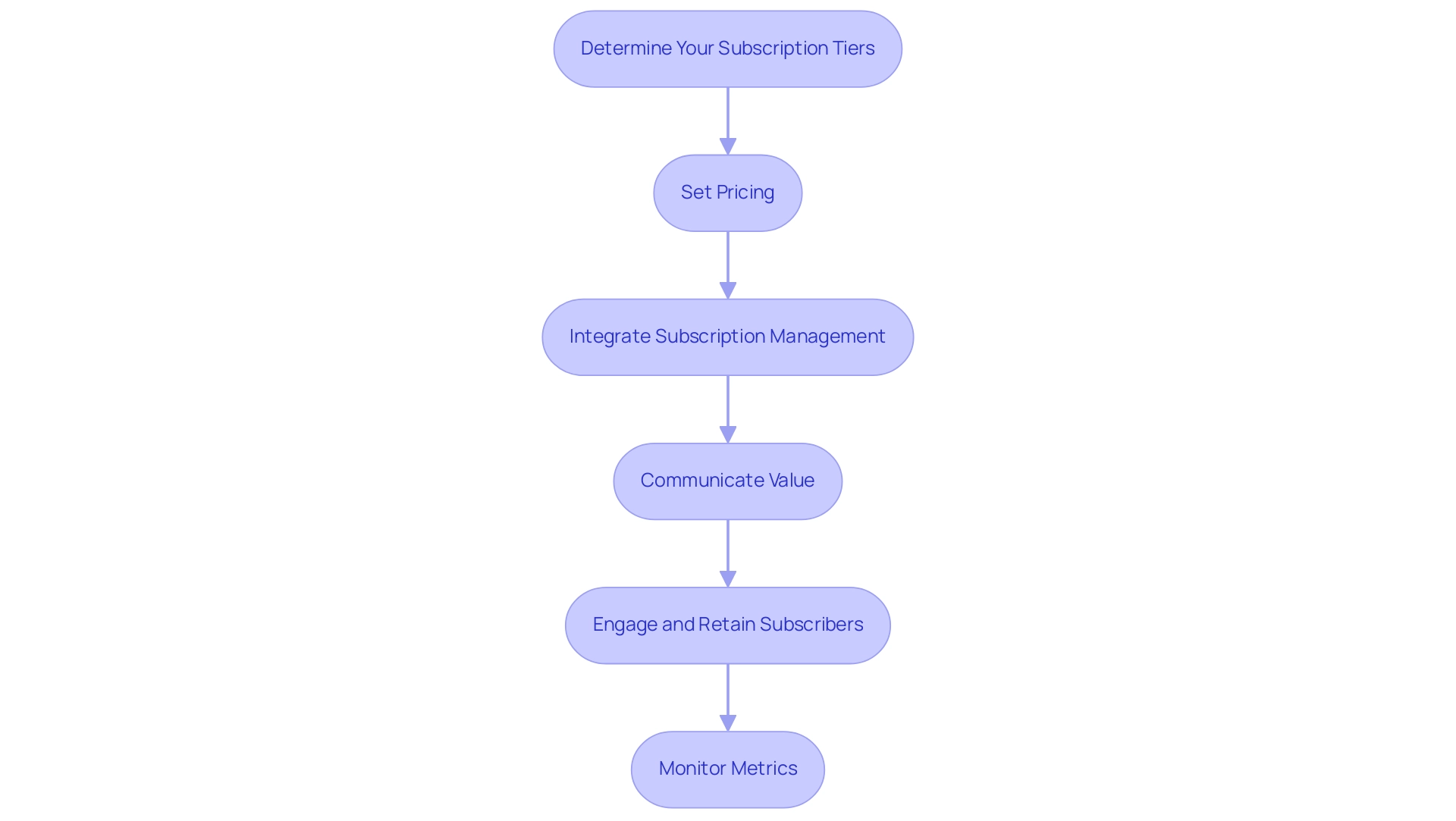
Utilizing the Freemium Model
To effectively implement the freemium model in your mobile app, it is essential to recognize that a customized monetization plan is crucial for app growth, as there is no one-size-fits-all approach. Consider the following strategies:
-
Define Free vs. Premium Features:
Establish a clear distinction between what features are free and what require payment. It's essential that the free version provides adequate value to draw in individuals without overwhelming them. As highlighted by Zapier, limitations on features can both enhance value perception and encourage upgrades. -
Integrate Upgrade Options:
Facilitate a seamless transition for individuals from the free version to the premium version. Ensure that clear calls-to-action (CTAs) are strategically placed within the app to direct individuals toward the upgrade process, enhancing the likelihood of conversion. -
Market the Premium Features:
Leverage in-app messaging and targeted marketing campaigns to spotlight the advantages of the premium version. Highlighting unique features can significantly influence perceptions and drive upgrades, especially in a competitive landscape where the average install rate on the App Store was just 3.8% in early 2024. -
Gather Feedback:
Regularly solicit opinions from individuals regarding both free and premium features. This data is invaluable for refining your offerings and ensuring they meet client needs and expectations. Understanding preferences can also inform future iterations of your app. -
Analyze Conversion Rates:
Keep a close eye on your conversion rates from free to paid customers. Recent data shows varying success rates, with apps in the Medical category achieving an impressive 16.3% install rate, while Games categories lagged at 0.6%. Analyzing this data helps identify what drives individuals to upgrade, allowing for targeted refinements in strategy. -
Utilize Cross-Promotion:
Consider cross-promoting your app with others that share a similar audience. This approach can improve your app’s outreach and adoption rates, as shown by a study revealing that 54% of organizations credit over 20% of their revenue to collaborations. -
Iterate and Improve:
Continuously enhance both your free and premium offerings based on feedback and ongoing market trends. Regular iterations will sustain user engagement and encourage more users to transition to premium offerings, ultimately driving revenue growth.
By strategically utilizing the freemium model and considering these complementary strategies, you can attract a diverse user base while creating substantial revenue opportunities to make money with mobile apps through premium features.
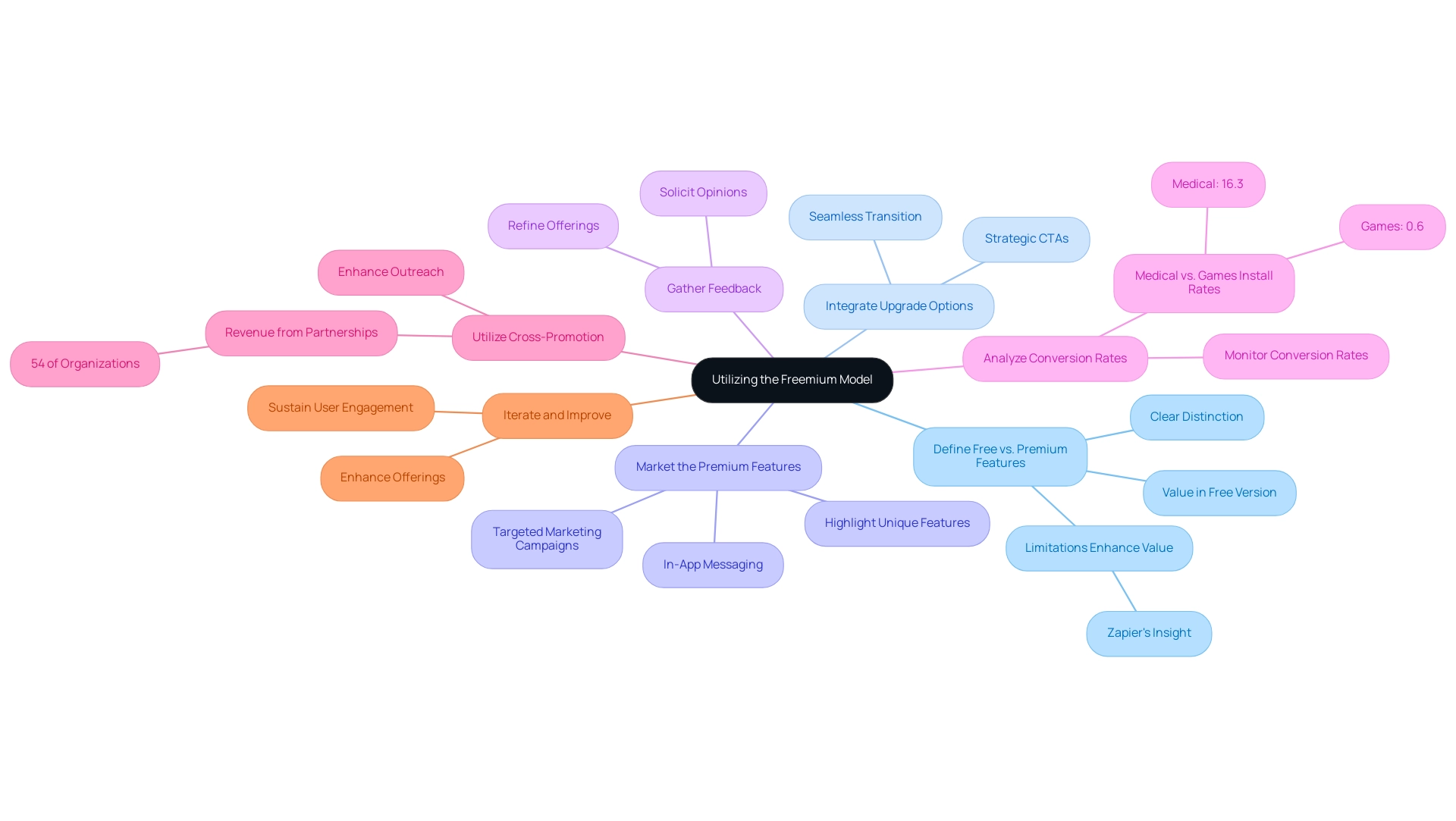
Conclusion
Implementing effective monetization strategies is crucial for mobile app developers aiming to thrive in a competitive market. The article outlines several key approaches, including:
- In-app advertising
- In-app purchases
- Subscription models
- Freemium structures
- Partnerships
Each approach offers unique advantages tailored to different user preferences and app types.
- In-app advertising stands out as a leading revenue generator.
- In-app purchases can significantly enhance user engagement, particularly in gaming.
- The subscription model provides a steady income stream, fostering user loyalty through exclusive content.
- The freemium model allows developers to attract a broader audience, converting free users into paying customers over time.
- Partnerships and sponsorships can further augment revenue, creating mutual benefits for brands and app developers alike.
Ultimately, the success of these monetization strategies hinges on a deep understanding of user behavior, market dynamics, and the app's unique value proposition. By continuously optimizing these strategies and remaining attuned to user feedback, developers can not only maximize revenue potential but also build lasting relationships with their users. In a rapidly evolving digital landscape, the right monetization mix will ensure that apps not only survive but thrive, remaining relevant and valuable in the eyes of their users.





